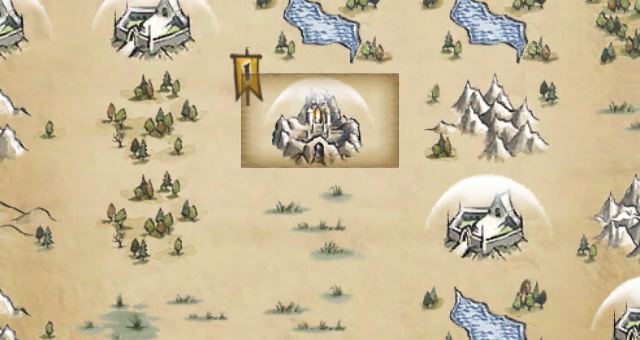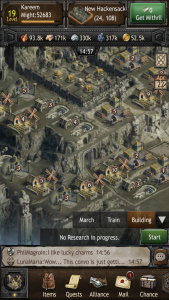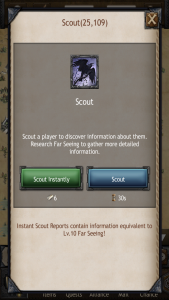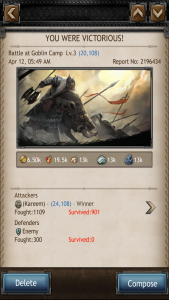
The Hobbit: Kingdoms of Middle Earth
-
The good
Rich strategy game where you can research technology, join alliances and build an army. Easy to learn for beginners but deep enough for veteran players
-
The bad
Can't queue the upgrade or construction of buildings. Defenses can be wiped out completely with one battle
-
The ugly
- Total score
The Hobbit: Kingdoms of Middle Earth is a free-to-play massively multiplayer strategy action game developed by Kabam based on the lore of the LOTR series. The game is set beyond the Misty Mountains in Middle Earth and you requires you to drive out the Goblin forces in the area while establishing either a Dwarven or Elven Kingdom. So not only will you have to worry about threats from the outside but also manage the resources of your kingdom wisely in order to provide for your population. You’ll also fight alongside known heroes such as Gandalf, Bilbo, Thorin and Radagast to defeat the Goblins. However there are underlying tensions between the Elves and the Dwarves so you’ll have to compete and defend against other players as well. Choose your side and your alliances wisely in order for your kingdom to survive and prosper.
GAMEPLAY
The Hobbit: Kingdoms of Middle Earth starts with a tutorial of the game play mechanics and if you’ve ever played a RTS before it’s just a matter of learning where everything is to get started. It’s important to state early on that this game is built around microtransactions. You don’t have to purchase anything in order to play but it can take considerably longer to complete certain tasks as you level up. Now, with that out the way the game suggests strongly after the tutorial that the player follow the tasks in the Quests tab and for beginners I suggest the same thing. Not only does it help the player become more familiar with the nuances of the game but the rewards from completing the quests will help out alot in the early stages.
The game consists of 3 maps: the castle, field and world maps and you can manage different resources and perform different tasks on each one. On the castle map you construct and upgrade all the essential buildings for your kingdom to function. There’s the Keep, which is the heart of the city and where you can change your tax rate, view your resources production and your conquests of other locations. There are other buildings such as barracks, the Great Hall, the Academy and of course houses. It’s everything that is guarded by your city walls. Every building on the castle map serves an important function and aside from houses and barracks you can only have one of each building. Clicking on one of these buildings gives you access to the functions of that building. If you select the Academy, for example, you can see all the research topics, the level you’re at for each of those topics and select a topic to research. All these buildings are upgradeable and yields more benefits for each upgrade.
The field map is for everything right outside your city walls and where you manage all the resources for your city. This is where you build your farms, lumber mills, quarries and mines for food, wood, stone and ore, respectively. This forms the backbone of your city. Everything you build or upgrade requires a certain amount of these resources as does any research you conduct. The number of plots available for these items depends on the level of your Keep. And just like all other buildings you can upgrade your farms, etc so they produce more of these resources per hour. One problem is you can’t queue the construction of buildings. So you can’t select the next building to construct or upgrade while one is already under construction. And although these buildings are outside your city walls the resources they generate can still be protected according to the level of the vault within your city walls. Protected from what? From other players of course. This is a massively multiplayer strategy game.
And lastly the world map is where you can see the area surrounding your city that you can occupy as well as the cities of other players. There are goblin camps, plains, mountains, woods and other locations you can scout and attack. You can scroll the map and select anything on it or you can put in coordinates to jump right to a location on the map. You can also bookmark locations as well. You don’t have to just scout or attack other cities. You can send messages to the owner of the city as well. In case the interactions don’t go well it’s good to have a strong army and defenses to protect yourself (or maybe you just enjoy raiding other locations).
There are a few buildings you can construct and upgrade to help in defending your city or make it difficult for another player to even scout your city but you will definitely need to train units to be effective. Your kingdom has a Might rating, which is basically the strength of all your units combined. Units are broken into 3 categories: Foot, mounted and ranged. Foot units are strong against mounted units, mounted units are strong against ranged units and ranged units are strong against foot units. So you will need a balance of the different types of units to maximize your true Might. The type of combat units you can construct depend on the level of your barracks and the level of your research topics. So obviously a more advanced unit is stronger than a basic unit. Unlike buildings you can queue the different types of troops you want to train so once one set of troops is trained the next set is automatically trained as well. You can use these troops to defend your city (I advise against that) or you can hide them in your city and just use them to attack other cities. You can train defensive units by selecting your city wall but unlike the troops in your barracks they can’t attack other cities. It can be advantageous to at least attack low-level areas if for no other reason than for one of your heroes to gain experience and level up. You can use heroes in other parts of your city as well to increase production and the more experience a hero has the more benefits they provide.
Just like it’s possible to attack other players it’s also possible to help other players or receive help from them. The best way to do so is by joining an alliance. Each alliance has its own requirements to join or remain a part of it but doing so can be extremely important especially when everything in your kingdom reaches a certain level. The resource requirements go up alot. The game has a separate section to search through the different alliances and send requests to join so you don’t have to go through the built-in game chat to request information about different alliances. Once you do join one there’s a specific tab so you can see only your alliance members in chat and here you can respond to requests for help or make your own request for anything. The game makes it almost as easy as a click of a button.
I’ve been playing the Hobbit: Kingdoms of Middle Earth for over a month and I’ve been enjoying it. Once I got accustomed to where everything was located in the interface it became very easy to use. There’s a bar containing what the game considers to be the most used features such as training and research so you can access them regardless of which map you’re currently viewing. It’s especially helpful because on smaller devices it can be difficult to discern which building is which due to the graphics. And since there are certain buildings that can only be built once there isn’t a legend that you can view to identify the building on the map. So in my first week of playing I would sometimes have to click on every building before finding the one I wanted. That says more about the graphics than about the actual gameplay. It doesn’t support rotating screens and that would have been a huge plus. There are also no cutscenes or animations as a result of achievements or combat. But if you started this game looking for amazing graphics you picked the wrong game because the fun is in the actual gameplay. There are enough tasks to manage in your city for even some hardcore strategy game fans and if you acquire the correct items from conquering other lands you can build a second city to manage as well (an update was recently released to allow for a third city). Joining an alliance is almost a necessity unless you don’t mind waiting for days (or microtransactions) to acquire enough resources and hoping not to get attacked in the meanwhile. Also while waiting for an upgrade you can enter chat to help out allies or find new locations to scout or attack so there’s plenty to do to pass the time. Combat isn’t complicated and is mainly a matter of having more might than an invading or defending force and loot is automatically taken based on the units sent and the resources left unprotected. A problem I have with combat is the fact it’s all or nothing and that can render defenses almost useless.
The losing force is completely wiped out. So if you spend a week’s worth or resources building up your defenses and you’re attacked by a stronger player all of those units are destroyed immediately. You can request allies to send you troops to protect your cities but considering the same could happen to their troops it’s so much better earlier on to hide your troops and just hope to launch a counterattack. Despite that it’s still a very enjoyable game that can be played anywhere for a quick strategy game fix.
SUMMARY
The Hobbit: Kingdoms of Middle Earth is an enjoyable massively multiplayer strategy game. It won’t replace other MMORTS games or even a single-player strategy game like Civilization but it does provide an excellent fix on the go for MMORTS or strategy game players. The time it can take for certain topics to be researched or buildings to be upgraded (8 hours for one) once you reach the higher levels can be very restrictive. However there’s enough here that you if you do take time to learn the nuances this game offers you will be rewarded with a relatively deep system, bonuses and interactions that will keep you coming back for more. I recommend giving it a try. It is, after all, free.




2 comments
hobbit kom fanboy313 - January 3, 2014 3:53 PM
it’s a great review you have uploaded 10 out of 10
Pingback: The Hobbit Kingdoms of Middle Earth 2nd City - Hulking Reviewer